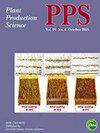The impact of phytochemical, morpho-physiological, and biochemical changes of Lallemantia royleana (Benth.) on drought tolerance
IF 1.3
3区 农林科学
Q2 AGRONOMY
引用次数: 1
Abstract
ABSTRACT Water deficiency is the most prominent constraint for crop production worldwide which is exacerbated by climate change. Developing drought-resistant species is a cost-effective solution to resolve the water lack problems in arid and semi-arid regions. A two-year study was conducted with the aim of developing the cultivation of Lallemantia royleana drought-resistant ecotypes in desert climates. Drought treatments were included control (−0.5 atm), mild (−3.5 atm), moderate (−6.5 atm), and severe (−9.5 atm). Balangu ecotypes were collected from Kalat in Khorasan Razavi province, Zakheh in Kurdistan province, Kondor in Alborz province, and Jupar in Kerman province. The results showed that Kondor and Jupar were drought-resistant ecotypes, and Kalat and Zakheh were drought-sensitive ecotypes. Growth traits, RWC, photosynthetic pigments content, seed yield, seed oil amount, and omega-6 fatty acids contents in all ecotypes decreased in drought conditions. On the contrary, the content of seed mucilage and soluble carbohydrates, the activity of APX, CAT, SOD, and POX, and the amount of phenol and proline increased. However, the drought-tolerant ecotypes produced more dry matter and seed yield under drought conditions. They can use a large amount of photosynthetic energy for biomass and seed production up to −6.5 atm of soil water potential. However, this ability is retained up to −3.5 atm of soil water potential in drought-sensitive ecotypes. Graphical Abstratct大豆Lallemania royleana(Benth.)的植物化学、形态生理和生化变化对耐旱性的影响
摘要:缺水是全球作物生产最突出的制约因素,气候变化加剧了这种制约因素。开发抗旱物种是解决干旱和半干旱地区缺水问题的一个具有成本效益的解决方案。进行了一项为期两年的研究,目的是在沙漠气候中发展Lallemania roleana抗旱生态型的栽培。干旱处理包括对照(−0.5 atm)、轻度(−3.5 atm)、中度(−6.5 atm)和重度(−9.5 atm)。Balangu生态型采集自呼罗珊-拉扎维省的Kalat、库尔德斯坦省的Zakheh、阿尔伯兹省的Kondor和克尔曼省的Jupar。结果表明,Kondor和Jupar是抗旱生态型,Kalat和Zakheh是干旱敏感生态型。干旱条件下,所有生态型的生长性状、RWC、光合色素含量、种子产量、种子含油量和ω-6脂肪酸含量都有所下降。相反,种子粘液和可溶性碳水化合物的含量、APX、CAT、SOD和POX的活性以及酚和脯氨酸的含量增加。然而,耐旱生态型在干旱条件下产生了更多的干物质和种子产量。它们可以将大量的光合能量用于生物量和种子生产,最高可达−6.5个大气压的土壤水势。然而,在干旱敏感的生态型中,这种能力在高达−3.5大气压的土壤水势下仍能保持。图解文章摘要
本文章由计算机程序翻译,如有差异,请以英文原文为准。
求助全文
约1分钟内获得全文
求助全文
来源期刊

Plant Production Science
农林科学-农艺学
CiteScore
5.10
自引率
4.00%
发文量
27
审稿时长
>36 weeks
期刊介绍:
Plant Production Science publishes original research reports on field crops and resource plants, their production and related subjects, covering a wide range of sciences; physiology, biotechnology, morphology, ecology, cropping system, production technology and post harvest management. Studies on plant production with special attention to resource management and the environment are also welcome. Field surveys on cropping or farming system are also accepted. Articles with a background in other research areas such as soil science, meteorology, biometry, product process and plant protection will be accepted as long as they are significantly related to plant production.
 求助内容:
求助内容: 应助结果提醒方式:
应助结果提醒方式:


